► Exclusive access inside BMW’s go-faster M division
► Up close and personal with red-hot new M2
► M4 GTS is fastest production car BMW’s ever built
Pessimists might accuse BMW’s M Division of losing focus. New boss Frank van Meel joined from understeer specialists quattro GmbH; the M4’s turbo engine can’t hold a candle to the old M3’s V8; and Hyundai snaffled second-in-command Albert Biermann. Are the alloys falling off the ultimate driving machine?
Not if the M2 and M4 GTS can deliver. Today we’re at M headquarters in Garching, Munich to learn more about these key new models, chewing the details with van Meel, new vice president Dirk Haecker, and chassis engineers, engine specialists and project managers too. Both M2 and M4 GTS go straight for the M jugular – steroidal looks, thumping power, driver-focused rear-drive chassis – but nothing encapsulates the M ethos better than M2. Yours for £44,070 next April, the M2 is £9k costlier than M235i, £13k cheaper than M4. The turbo 3.0-litre’s outputs mirror that positioning: 365bhp and 343lb ft is 49bhp/11lb ft clear of the 30kg lighter M235i, some 60bhp/63lb ft off the 42kg heavier M4.
‘We wondered if we could do the M2, because the M235i is so good,’ reveals project manager Frank Isenberg. ‘But one drive in the M2 and you’ll know it’s a proper M car.’

The M2’s lineage brings its unfamiliar name into sharp focus: 2002 Turbo, E30 M3 – the epicentre of M DNA – and, most recently, the 1-series M, the first turbocharged M car (assuming the standard M-enthusiast procedure of ignoring the SUVs).
Contextually, the 1M is most important. Like the M2, the 1M arrived when M was under scrutiny – those SUVs – and rushed to market following a rummage in the M3 parts-bin. Just 450 1Ms came to the UK, and all quickly sold, proving that enthusiasts would forgive – or even embrace – a lack of polish in exchange for a raw and exciting drive.
The M2 is more of the same, just with uncapped numbers and extra polish that we’re assured won’t spoil the magic.
No-one else makes a rear-drive, four-seat sports car at this price. M Division pulls it off because it has the underlying 2-series architecture, and can tap economies of scale from the M4. What it cannot lift directly from the M4, it doesn’t try to replicate; no carbonfibre roof or bootlid here, and the blistered arches are nothing more exotic than steel. But the effect on the slightly gawky 2-series is stunning, a bulging body that brings to mind both E30 M3 and 1M.
That chunkier body – 55mm wider front, 80mm rear – isessential to cover a wider track courtesy of M4 forged aluminium suspension components. ‘The track is the same, but the M4 tyres wouldn’t fit, so the tyres are 10mm narrower,’ says Isenberg. The Michelin Pilot Super Sports measure 245/35 ZR19 front, 265/35 ZR19 rear.
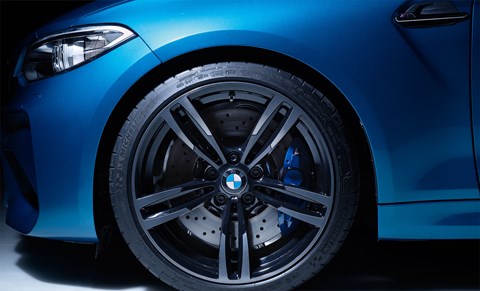
The suspension is matched to bespoke springs and dampers but there’s no adaptive suspension. ‘The problem with adaptive dampers is you’re changing the damper, not the spring, so you end up with a spring that is a compromise between two settings,’ explains Isenberg.
Underneath the M2’s squat body, additional bracing increases rigidity. ‘Boomerang braces’ arc between the headlamps and front wings, struts angled at 45 degrees glint through both kidney grilles like a rollcage through a rear window, and both the A-pillar and boot also sent for reinforcements.
The M4’s optional carbon-ceramic brakes aren’t offered, engineers arguing that the cost, plus the reduced power and weight of the M2 negate the need. Instead, regular M4 brakes are carried over – drilled discs all round, four-piston calipers front, two-piston rear – and you can ask your dealer for track pads; there’s no performance increase and they squeak, but they last longer.
Both transmissions are borrowed from the M4, ratios, final drive and all, and there’s the same M locking diff that’s been helping hoons powerslide for almost two decades. But here’s what I can’t fathom: the M4’s aluminium suspension sheds some weight, but there’s the wider track, larger wheels and brakes, a diff, the burlier bodywork and extra strengthening. How on earth is M2 only a claimed 30kg heavier than M235i?
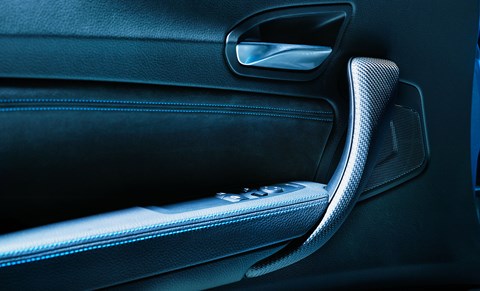
‘We ripped out all the sound deadening!’ laughs Isenberg. ‘So you hear more and it removes a lot of weight.’ I resist the urge to pick up the project manager and twirl him around, but I want to.
Sink down low – though no lower than the M235i – into leather sports seats, press the starter button and the M2 erupts through new quad wheelbarrow tailpipes. It’s a bassy drone at idle, but it sounds like a 325i with its balls dropped when the rpms climb, and it crackles when you release the throttle.
Under the bonnet there’s an M235i engine bolstered by M4 components. ‘The air intake is less restrictive, plus there are M4 pistons, liners and big-end bearings,’ says Isenberg. ‘We’ve also added the M4’s oil sump and pump, to match the higher lateral forces.’ An overboost function increases torque by 26lb ft between 1450-4750rpm, but the engine doesn’t rev any higher than the 235i’s at 7000rpm. Theintercooler is carried over from the M235i, but the radiator is larger and fed by a redesigned front bumper with larger intakes. Despite this, drag falls by 35%.
The M235i revs strongly and responds crisply, but Isenberg assures me that the M2 has even more accurate response due to careful calibration changes. He glides his hand through the air making tiny steps of adjustment to mimic the engine’s increased throttle precision.
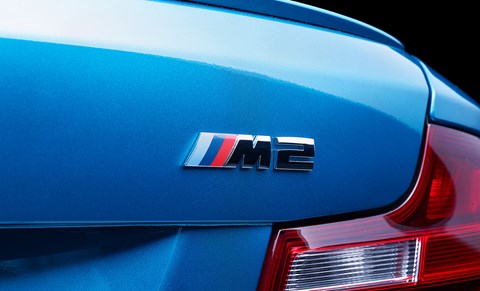
You’ll be giving that engine orders through either a six-speed manual or, unlike the 1M, an optional dual-clutch gearbox; the latter likely to take 60% of sales. But like the 1M, the M2 largely shuns gadgetry.
Hence the DCT’s DriveLogic controller has vanished, and the M4 steering wheel has blanks where the M Performance buttons for suspension, throttle and more should reside.
It’s not a faff-free zone, though: a switch next to the gearstick controls Comfort, Sport and Sport+ throttle, gearbox and steering maps, and you can’t separate the modes, for instance if you want lighter steering but a sharper throttle and gearshift.
The 1M rode like it had ants in its pants, and you caught its oversteer more with punches than steering inputs. I ask if that feistiness was intentional, or a by-product of the M melting pot. ‘By-product,’ confirms Isenberg. ‘We were still learning with the turbocharged engine. For the M2, the ride is much more compliant, and it’s not so tricky at the limit.’
The big question, of course, is how M2 compares with M4, and which Isenberg prefers. ‘M2,’ he answers without hesitation. ‘I like the smaller cars. The M2 might even be faster through a tight slalom.’ Or around the Nürburgring. Officially, the M2 is good for a 7min 58sec, the M4 a 7min 52sec. The 1M did 8min 15sec.
Caught between a more agile, almost-as-rapid sibling, and journalists moaning about a boring engine, the M4 had to react. The result is the M4 GTS, still powered by a twin-turbocharged straight-six, but an altogether more serious proposition. Chassis engineer Joerg Weidinger drove it to a 7min 28sec ’Ring lap, 30 clear of M2.
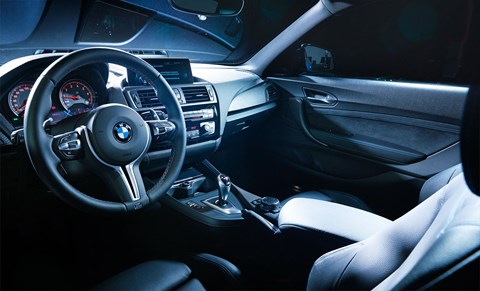
‘We had a week, but it rained most of the time,’ he remembers, ‘Thursday was okay, so we spent the day tuning the dampers, and I had one run in the evening. Maybe I could go faster, but I was pretty close to the limit. It was a good run!’
The M4 GTS follows on from M3 GTS with a similar recipe: lightweight components, extra power, sticky tyres, pseudo motorsport vibe and, oh yes, an unimaginably huge price tag and limited numbers: just 30 of 700 units are UK-bound, priced at £122,070.
But it’s the chassis that’s key to performance, the GTS riding on race-style adjustable coilovers. Not the press-a-button stuff, but the kind of suspension which means you’ll need to get the car on a ramp to tinker with the compression and rebound, and crank the ride height down by as much as 15mm. Ultimately, though, the GTS has been designed for road and track use. ‘We never trailer these cars during testing,’ reveals Weidinger. ‘I personally did 40 or 50,000km in the GTS, going to the Alps, southern France… Basically the Nürburgring setting is our street setting because you still need compliance on the ’Ring.’
‘I thought the M3 GTS was too firm,’ chips in Isenberg, ‘but the M4 GTS is much more supple.’
So after Weidinger did his ’Ring settings, he cross-checked them on the road, in the wet, and on cold tyres. From there he developed the race set-up, stiffer and lower for the longer corners and smoother surfaces of more typical racetracks like Hockenheim and Bilster Berg.
The GTS rides on honeycomb alloys with Acid Orange highlighting, like Bandit’s Trans Am, and it gets really interesting when you look at the rubber. The production car will use more aggressive Pilot Cup 2s, which weren’t fitted for our shoot. But the dimensions are representative. The fronts are 265/35 ZR19s, and their reasonably chunky sidewalls rise vertically from the wheel lip. Just like the 911 GT3 RS, the rear wheel measures 20 inches – with 285/30 ZR20 tyres – and the thinner sidewall tapers aggressively inwards. ‘The thinner sidewall makes the car much more reactive,’ explains Weidinger.
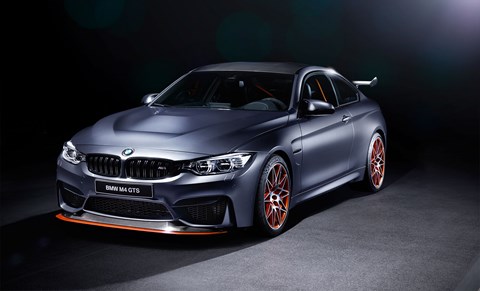
Also noticeable is the extra negative camber on the front and rear wheels. It’s more pronounced on the rears, suggesting more understeer. ‘The settings are not finalised yet,’ cautions Weidinger, ‘but the handling is more neutral than the standard M4. It makes the steering feel different too: stiffer and keener to self-centre.’
The Allen-key adjustable rear spoiler and Acid Orange front splitter contribute to large aerodynamic gains, and the stuff you can see combines with stuff you can’t, notably a smoother under-floor that helps channel air to the rear diffuser, increasing downforce. Weidinger can’t quote figures, but he says it makes a big difference: ‘You trust the car much more on crests and uneven sections. Where you’d be tentative in an M4, here it’s just full throttle, easy. It’s more stable, but more exciting, because you have to learn to trust the aero and use the speed.’
Weidinger has calculated there are 2500 possible set-up options thanks to the adjustable suspension and aerodynamics, and therefore 2499 ways to mess up his factory settings. In the pictures, the rear spoiler is cranked to its steepest angle, the front splitter jutting like a lizard’s tongue. The splitter’s a trip hazard and actually not road-legal in this configuration; it brings to mind the old E9 CSL ‘Batmobile’, which was supplied with its uncertified aero mods in the boot, for owners to fit for track use.
Ah yes, CSL. You might think GTS lacks the heritage of the Coupe Sport Leichtbau, but there’s perhaps a reason why those three iconic letters weren’t suitable: the GTS isn’t particularly light, despite appearances. On top of the standard car’s carbon roof and boot, it gains a carbon bonnet (vented for cooling and to reduce front-end lift), 6kg lighter titanium exhaust, the M4’s normally optional carbon stoppers, plus lightweight bucket seats and panels in the back instead of rear seats. These mods save 60kg, yet the water-injectiontank, larger wheels and rollcage pile weight back in. As a result, the GTS is only 30kg lighter than a regular M4 with DCT transmission.

In the old days, BMW might have developed different cams and an airbox – E46 CSL – or even increased the capacity, as with the E30 Sport Evo and the last GTS. This time the twin-turbocharged straight-six is identical save for one thing: water injection. But it makes a bigger difference than previous conventional tuning, with claimed 68bhp and 37lb ft increases – albeit complemented by ECU tweakery – for 493bhp and 443lb ft all told. ‘When I first drove this car, it scared me,’ admits Isenberg. ‘It’s so fast, it takes time to learn and trust.’
A technology seen in rallying well over a decade ago, water injection squirts water into the inlet manifold via three injectors, where it evaporates, cooling the turbocharged air supply. There’s a five-litre tank in the boot and BMW says you’ll top it up every time you re-fuel on track, every five stops during fast motorway driving.
The M4 GTS sounds like a more serious, more race-car-like experience than the M3 GTS, with a set-up that’s perhaps not as initially intuitive, but ultimately faster. Feels like a serious machine when you climb in too, especially with the no-cost Clubsport pack with its half rollcage, fire extinguisher and six-point race harnesses. The fixed-back bucket seats are set way down low, but the bolsters are trimmed in deeply padded leather to avoid bruising on entry, as it were, and the Alcantara centres are grippy and comfortable; they look more bespoke than the M3 GTS generic buckets. They’re half the weight of the standard seats, the savings ramped up by door casings made from the same lightweight recycled plant material first seen on the i3. The doors make a noticeably thinner sound when you slam them using the too-far-forwards fabric door pulls. Ostensibly the pulls are there to save weight, and yet there’s sat-nav, cruise control, air-con, even parking sensors; wealthy trackday rats are a perverse bunch.
I sit in the GTS, feeling the reassuring squeeze of the seats under my arms, the harness clasps occasionally clinking on the rollcage. I trace my thumbs around the thinner alcantara rim with its M tricolor stitching and slot them in at the quarter-to-three position, tapping at the gearshift paddles with their precise clicks of engagements. I press the start button, and that straight-six barks fiercely through quad titanium exhausts, the revs flaring instantly, bombarding your ears, ramping up with a prod of the Sport button; it feels edgy and alive, adding the attitude that the standard car lacks.
I want the M4 GTS to be good, but I need the M2 to be great. Powerful, focused, compact and affordable, it should be the ultimate embodiment of everything M represents. We’ll find out for sure early next year.

The specs: BMW M2
Price: £44,070
Engine: 2979cc 24v turbo six-cylinder, 365bhp @ 6500rpm, 343 lb ft @ 1400-5560rpm, plus 26lb ft overboost from 1450-4750rpm
Transmission: Seven-speed dual-clutch, rear-wheel drive
Suspension: MacPherson strut front; multi-link rear
Performance: 4.3sec 0-62mph, 155mph, 35.8mpg, 185g/km
Weight: 1495kg
On sale: April 2016
The specs: BMW M4 GTS
Price: £121,770
Engine: 2979cc 24v twin-turbo six-cylinder, 493bhp @ 6250rpm, 443lb ft @ 4000-5500rpmTransmission Seven-speed dual-clutch, rear-wheel drive
Suspension: MacPherson strut front; multi-link rear
Performance: 3.8sec 0-62mph, 190mph, 34mpg, 194g/km
Weight: 1510kg
On sale: June 2016
Meet Frank van Meel, the new Mr M Sport
Born in Holland in 1966, he graduated from Technical University Berlin with a degree in automotive engineering, beginning his career at ITT Automotive in 1994. He started at Audi in 1996, rising to managing director quattro GmbH in 2012. Joined BMW in 2014
What was your first experience of an M car? I worked for ITT Automotive in the mid-1990s when ESC was new, and developed the stability control for the E46 M3 with Dirk Haecker…
Did you bring Haecker to M? Yes.
What is your favourite M car from the past? The 1-series M. That car definitely needs ESC!
What are M Division’s values? M cars are about precision, dynamics, agility and innovation. We are strong to our principles, and only the technology changes: the M3 has had a 4-, 6-, 8- and now a 6-cylinder turbo. Our image is also important for the rest of the group: we are the ultimate ultimate driving machine.
M stands for Motorsport. Is motorsport still important? Motorsport is key. We transfer our learning from the racetrack, and DTM drivers feed in to our development programmes.

Has M’s switch to turbocharging been successful? Turbo engines are great for mpg, torque and performance, and we’ve kept M’s trademark high-revving performance. I think the transition has been quite smooth, although of course it’s hard to replace a V8.
How will M Division evolve under your leadership? We will look to traction systems and tyre technology to help put more power down. We will become more aggressive about sound, that’s very important. The little backfire you hear on the M4 GTS… an engineer might say that’s perhaps a mix up with the ignition spark, but it creates emotion.
Will the next M5 be all-wheel drive? We are investigating all options, and there is no dogma as to what we can do. All-wheel drive can be a good solution, but the front axle can lose precision, so you must be careful.
How involved do you get in the development process? I drive the cars early. Usually the engineers have picked up on the same things, but it’s good to have input.
How do the M4 GTS and M2 compare? They are different worlds. The GTS is a real racing car, completely reworked. But the M2 has a shorter wheelbase, and it’s very agile with go-kart steering. It has more grip than the 1-series M, and is easier on the limit. It gives you good confidence. The regular M4 has a broader brief than the M2; it allows the M2 to be purer.
We’ve now got M2 above 235i. Will we see M1 above M135i? No, the coupe is coolest, and we didn’t want to lose our focus.
M people: the heroes inside

Joerg Weidinger: The Nürburgring lap-setter
Joined M Division as a chassis engineer in 2013, having previously worked on the fantastic Mini GP. He’s a keen racer and hill climber, and boss van Meel chose him to set Nürburgring times for both the M235i (7min 58sec) and M4 GTS (7min 28sec). ‘When the weather cleared for the GTS lap, Joerg knew he had one chance,’ says van Meel. ‘He was totally calm, and when you see the video of the lap, he just looks so relaxed. He was incredible under that pressure.’

Dirk Haecker: The vice president
Haecker arrived at BMW in 1988, working in chassis development, plus instructing in an E36 M3. In 2009 he switched to overall vehicle development, including heading BMW’s driver-assistance systems, and he became head of development for axles, steering and suspension in 2013. ‘M stands for pure, concentrated cars that are great on road and thrilling on track. Mr van Meel and I have the same ideas for the future, and we’re both engineers; I can’t fool him!’
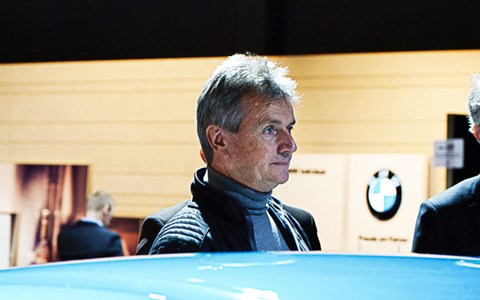
Frank Isenberg: The project manager
First drove an M car in 1985, when he received driver training in an E30 M3 soon after joining BMW. But he’s an enthusiast too: when he couldn’t afford a 2002 Turbo, he tuned a regular model with Weber carbs and a hot cam. ‘The small cars are my favourites,’ he says.
Isenberg joined BMW in 1984 as a chassis engineer, and worked on the E32 7-series. He left to work at Land Rover, returning to BMW in 1999. He was the man behind the rough diamond that is the 1M.

Marcus Engelke: The engine guru
Engine specialist Engelke project manages six-cylinder M cars. He joined BMW in 1999, and began specialising in engine control electronics. ‘We do all this in-house at BMW,’ he says proudly. Joined M in 2011, and is responsible for the M4 GTS’s water-injection system. ‘It gives a large power increase by cooling the intake air and making it denser,’ he explains. ‘You have to fill up the tank at the fuel station, but I think the M guys will like doing it; it’s something special’